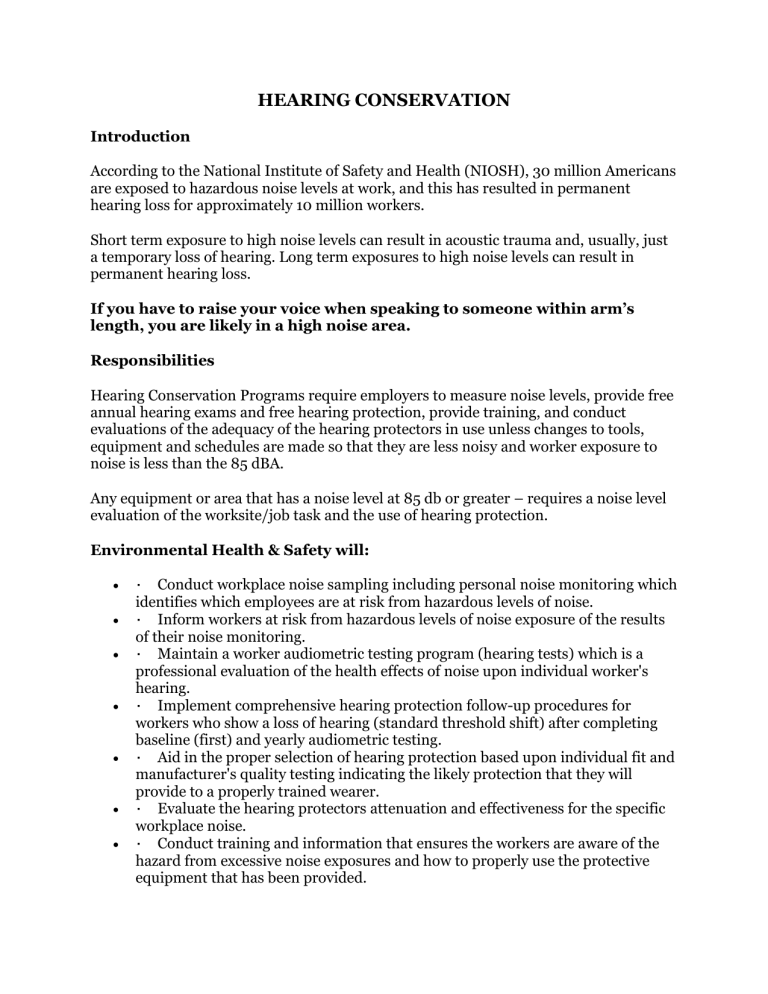
HEARING CONSERVATION Introduction According to the National Institute of Safety and Health (NIOSH), 30 million Americans are exposed to hazardous noise levels at work, and this has resulted in permanent hearing loss for approximately 10 million workers. Short term exposure to high noise levels can result in acoustic trauma and, usually, just a temporary loss of hearing. Long term exposures to high noise levels can result in permanent hearing loss. If you have to raise your voice when speaking to someone within arm’s length, you are likely in a high noise area. Responsibilities Hearing Conservation Programs require employers to measure noise levels, provide free annual hearing exams and free hearing protection, provide training, and conduct evaluations of the adequacy of the hearing protectors in use unless changes to tools, equipment and schedules are made so that they are less noisy and worker exposure to noise is less than the 85 dBA. Any equipment or area that has a noise level at 85 db or greater – requires a noise level evaluation of the worksite/job task and the use of hearing protection. Environmental Health & Safety will: ▪ Conduct workplace noise sampling including personal noise monitoring which identifies which employees are at risk from hazardous levels of noise. ▪ Inform workers at risk from hazardous levels of noise exposure of the results of their noise monitoring. ▪ Maintain a worker audiometric testing program (hearing tests) which is a professional evaluation of the health effects of noise upon individual worker's hearing. ▪ Implement comprehensive hearing protection follow-up procedures for workers who show a loss of hearing (standard threshold shift) after completing baseline (first) and yearly audiometric testing. ▪ Aid in the proper selection of hearing protection based upon individual fit and manufacturer's quality testing indicating the likely protection that they will provide to a properly trained wearer. ▪ Evaluate the hearing protectors attenuation and effectiveness for the specific workplace noise. ▪ Conduct training and information that ensures the workers are aware of the hazard from excessive noise exposures and how to properly use the protective equipment that has been provided. ▪ Assist with the data management of and worker access to records regarding monitoring and noise sampling. Regulatory Guidelines OSHA has specific regulations pertaining to hearing conservation and noise exposure. 29 CFR 1910.95 outlines rules that employers are required to follow. Specifically, if an employee is exposed to 85 decibels or above for an 8-hour time- weighted average, then he/she must be enrolled in a hearing conservation program. This program consists of annual training and audiometric exams. If an employee is exposed to 90 decibels or above for an 8-hour time-weighted average, or the equivalent for a shorter time period, the employer must use engineering controls to mitigate this exposure. If these controls are insufficient, the employer must provide hearing protection devices. Hearing protection devices consist of earplugs and earmuffs. Earmuffs are easy to put on and remove, and they provide extra protection for cold temperatures. Earplugs are as effective if they are worn properly, and they can be worn with glasses and helmets. It is the employee’s responsibility to notify his/her supervisor of concerns about a noisy workplace. Environmental Health and Safety can do monitoring of the area to evaluate the noise levels. It is also the employee’s responsibility to wear hearing protection devices, when provided, to attend annual training, and to have annual audiograms, if required.


